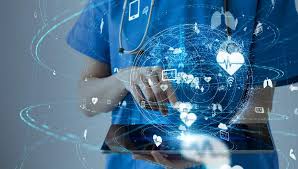AI for accessible, affordable and accurate healthcare
One of the most important inputs to health is healthcare. Unfortunately, a big problem in today’s society is unequal access to this basic human right. According to a report by the World Bank and the WHO at least half of the world’s population is too poor to access essential health care service [1]. Artificial intelligence (AI) could be a piece of the puzzle in solving this problem. AI makes use of complex algorithms and software to emulate human cognition in the analysis, interpretation and comprehension of complicated medical and healthcare data [2]. The primary aim of health-related AI applications is to analyse relationships between prevention or treatment techniques and patient outcomes [3]. But how can all this make an impact?
Accessibility
Access to basic and specialist healthcare varies vastly across countries and even cities. In order to bring healthcare closer to the patient AI can help by providing doctors with high-quality diagnostic images regardless of geographical location. This means that doctors are able to analyse and diagnose from anywhere in the world! This application is already making traction in the U.S. Start-up InfiniteMD provides second-opinion video consultations to patients around the world [4]. Building on that they are even developing an algorithm that aids in treatment decision-making and connects them with a global treatment operation or clinical trials [5].
Affordability
AI can significantly cut down the cost of healthcare by analysing medical and visitation data. Machine learning can find patterns in patient admission and discharges to determine which patient categories tend to overstay in hospitals and reduce patients stay accordingly. Additionally by powering virtual chat bots, AI can eliminate unnecessary in-person doctor visits and readmission, which can potentially save billions of dollars annually.
Accuracy
AI can be used to predict diseases in early stages by analysing data or imaging. This could aid doctors in diagnosing diseases and rule out false negatives, which is very valuable. The UK government is already working on this. They are building a new medical technology centre that will use AI to aid in disease diagnosis. The London Medical Imaging and Artificial Intelligence Centre for Value-Based Healthcare, will apply AI to detect anomalies in scans, helping with earlier detection. Intelligent information will set new precedents when it comes to diagnosis accuracy [6].
As with many new technologies, AI still has a lot to answer for. There are questions about privacy, safety, accuracy and ethics that we still need to examine. Yet, I do believe that there is a lot of potential and ground to be gained by combining machine systems with care delivered by humans.
References:
- http://pubdocs.worldbank.org/en/193371513169798347/2017-global-monitoring-report.pdf
- https://en.wikipedia.org/wiki/Artificial_intelligence_in_healthcare
- Coiera E (1997). Guide to medical informatics, the Internet and telemedicine. Chapman & Hall, Ltd.
- www.infinitemd.com
- https://www.bizjournals.com/boston/inno/stories/profiles/2018/01/29/infinitemd-raises-15m-for-ai-that-gives-patients-a.html
- https://www.kcl.ac.uk/bmeis/research-impact/london-medical-imaging-and-ai-centre-for-value-based-healthcare


